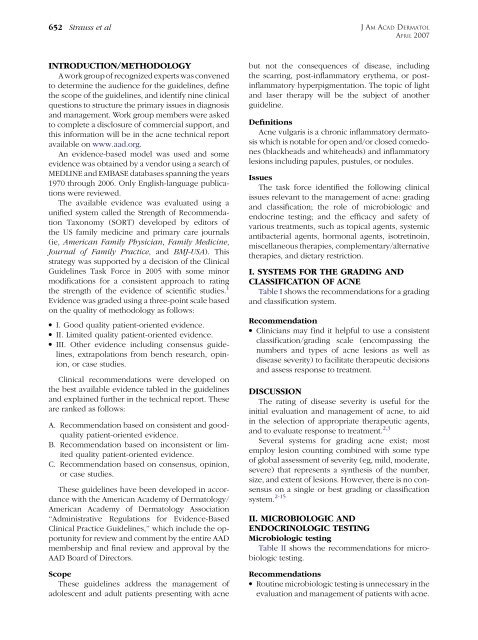Guidelines of care for acne vulgaris management
Guidelines of care for acne vulgaris management
Guidelines of care for acne vulgaris management
You also want an ePaper? Increase the reach of your titles
YUMPU automatically turns print PDFs into web optimized ePapers that Google loves.
652 Strauss et al<br />
JAM ACAD DERMATOL<br />
APRIL 2007<br />
INTRODUCTION/METHODOLOGY<br />
Awork group <strong>of</strong> recognized experts was convened<br />
to determine the audience <strong>for</strong> the guidelines, define<br />
the scope <strong>of</strong> the guidelines, and identify nine clinical<br />
questions to structure the primary issues in diagnosis<br />
and <strong>management</strong>. Work group members were asked<br />
to complete a disclosure <strong>of</strong> commercial support, and<br />
this in<strong>for</strong>mation will be in the <strong>acne</strong> technical report<br />
available on www.aad.org.<br />
An evidence-based model was used and some<br />
evidence was obtained by a vendor using a search <strong>of</strong><br />
MEDLINE and EMBASE databases spanning the years<br />
1970 through 2006. Only English-language publications<br />
were reviewed.<br />
The available evidence was evaluated using a<br />
unified system called the Strength <strong>of</strong> Recommendation<br />
Taxonomy (SORT) developed by editors <strong>of</strong><br />
the US family medicine and primary <strong>care</strong> journals<br />
(ie, American Family Physician, Family Medicine,<br />
Journal <strong>of</strong> Family Practice, and BMJ-USA). This<br />
strategy was supported by a decision <strong>of</strong> the Clinical<br />
<strong>Guidelines</strong> Task Force in 2005 with some minor<br />
modifications <strong>for</strong> a consistent approach to rating<br />
the strength <strong>of</strong> the evidence <strong>of</strong> scientific studies. 1<br />
Evidence was graded using a three-point scale based<br />
on the quality <strong>of</strong> methodology as follows:<br />
d<br />
d<br />
d<br />
I. Good quality patient-oriented evidence.<br />
II. Limited quality patient-oriented evidence.<br />
III. Other evidence including consensus guidelines,<br />
extrapolations from bench research, opinion,<br />
or case studies.<br />
Clinical recommendations were developed on<br />
the best available evidence tabled in the guidelines<br />
and explained further in the technical report. These<br />
are ranked as follows:<br />
A. Recommendation based on consistent and goodquality<br />
patient-oriented evidence.<br />
B. Recommendation based on inconsistent or limited<br />
quality patient-oriented evidence.<br />
C. Recommendation based on consensus, opinion,<br />
or case studies.<br />
These guidelines have been developed in accordance<br />
with the American Academy <strong>of</strong> Dermatology/<br />
American Academy <strong>of</strong> Dermatology Association<br />
‘‘Administrative Regulations <strong>for</strong> Evidence-Based<br />
Clinical Practice <strong>Guidelines</strong>,’’ which include the opportunity<br />
<strong>for</strong> review and comment by the entire AAD<br />
membership and final review and approval by the<br />
AAD Board <strong>of</strong> Directors.<br />
Scope<br />
These guidelines address the <strong>management</strong> <strong>of</strong><br />
adolescent and adult patients presenting with <strong>acne</strong><br />
but not the consequences <strong>of</strong> disease, including<br />
the scarring, post-inflammatory erythema, or postinflammatory<br />
hyperpigmentation. The topic <strong>of</strong> light<br />
and laser therapy will be the subject <strong>of</strong> another<br />
guideline.<br />
Definitions<br />
Acne <strong>vulgaris</strong> is a chronic inflammatory dermatosis<br />
which is notable <strong>for</strong> open and/or closed comedones<br />
(blackheads and whiteheads) and inflammatory<br />
lesions including papules, pustules, or nodules.<br />
Issues<br />
The task <strong>for</strong>ce identified the following clinical<br />
issues relevant to the <strong>management</strong> <strong>of</strong> <strong>acne</strong>: grading<br />
and classification; the role <strong>of</strong> microbiologic and<br />
endocrine testing; and the efficacy and safety <strong>of</strong><br />
various treatments, such as topical agents, systemic<br />
antibacterial agents, hormonal agents, isotretinoin,<br />
miscellaneous therapies, complementary/alternative<br />
therapies, and dietary restriction.<br />
I. SYSTEMS FOR THE GRADING AND<br />
CLASSIFICATION OF ACNE<br />
Table I shows the recommendations <strong>for</strong> a grading<br />
and classification system.<br />
Recommendation<br />
d Clinicians may find it helpful to use a consistent<br />
classification/grading scale (encompassing the<br />
numbers and types <strong>of</strong> <strong>acne</strong> lesions as well as<br />
disease severity) to facilitate therapeutic decisions<br />
and assess response to treatment.<br />
DISCUSSION<br />
The rating <strong>of</strong> disease severity is useful <strong>for</strong> the<br />
initial evaluation and <strong>management</strong> <strong>of</strong> <strong>acne</strong>, to aid<br />
in the selection <strong>of</strong> appropriate therapeutic agents,<br />
and to evaluate response to treatment. 2,3<br />
Several systems <strong>for</strong> grading <strong>acne</strong> exist; most<br />
employ lesion counting combined with some type<br />
<strong>of</strong> global assessment <strong>of</strong> severity (eg, mild, moderate,<br />
severe) that represents a synthesis <strong>of</strong> the number,<br />
size, and extent <strong>of</strong> lesions. However, there is no consensus<br />
on a single or best grading or classification<br />
system. 2-15<br />
II. MICROBIOLOGIC AND<br />
ENDOCRINOLOGIC TESTING<br />
Microbiologic testing<br />
Table II shows the recommendations <strong>for</strong> microbiologic<br />
testing.<br />
Recommendations<br />
d Routine microbiologic testing is unnecessary in the<br />
evaluation and <strong>management</strong> <strong>of</strong> patients with <strong>acne</strong>.

















